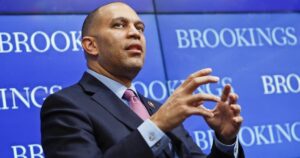Justice Department Dismisses Key Trump Prosecutors
The Justice Department has taken striking action by dismissing over a dozen officials affiliated with the prosecution of President Donald Trump, as announced by Acting Attorney General James McHenry.
This move is part of an ongoing effort to address President Trump’s claims of federal government weaponization.
Under McHenry’s directive, the Justice Department has issued termination notices to numerous officials from Special Counsel Jack Smith's team. These officials played integral roles in prosecuting Trump, but McHenry elaborated that their tenure could not continue due to apparent trust deficits concerning their ability to "implement the president’s agenda." While the identity of these officials remains undisclosed, the rationale behind their dismissal echoes Trump’s commitment to dismantling a federal apparatus he perceives as hostile.
History of Reassignments and Firings at DOJ
This sweeping overhaul within the Justice Department has drawn comparisons to actions taken during the inaugural week of Trump's administration, when several officials were reassigned. Such actions underscore an ongoing pattern of administrative changes aimed at aligning the department with the president's directives.
Jack Smith, appointed as special counsel by former Attorney General Merrick Garland in November 2022, was entrusted with overseeing investigations into Trump’s management of classified records and his alleged role in attempts to disrupt the peaceful transition following the 2020 election. These cases were significant markers in the legal challenges that Trump faced during and after his presidency.
The investigations resulted in charges against Trump, who maintained his innocence throughout the legal proceedings. However, both cases were eventually dismissed, with pivotal decisions supporting Trump’s position.
Details of the Dismissed Legal Cases
The classified documents case faced a critical setback in July 2024, when Judge Aileen Cannon dismissed it, citing the improper appointment of Jack Smith. This decision undermined the validity of the charges related to Trump’s handling of sensitive information, effectively nullifying the proceedings.
Similarly, the investigation into Trump's influence in the aftermath of the 2020 election saw a resolution in Trump’s favor. The case was voluntarily dismissed by Smith after Trump reassumed the presidency. Judge Tanya Chutkan affirmed this request, resulting in the closing of another chapter in Trump’s legal narrative.
The recent actions by the Justice Department form a critical element of Trump’s broader strategy to confront what he characterizes as the misuse of governmental power against him and his administration. These terminations symbolize a substantial shift in departmental dynamics, reinforcing Trump’s long-standing criticisms.
Implications and Reactions to DOJ Changes
An unnamed DOJ representative provided insight to Fox News Digital, confirming the dismissals and highlighting McHenry’s decision to remove those officials due to their previous actions, aligning with Trump’s aim to reform the government's use of power. The official’s comments reflected an emphasis on preventing what Trump describes as governmental overreach.
By reshaping the Justice Department’s personnel landscape, the administration seeks to establish a foundation aligned more closely with its vision. The officials’ removal may also serve as a cautionary tale for those perceived as obstacles to the current administration's agenda.
The terminations were communicated through letters dispatched by McHenry, although specifics regarding their wording or the immediate reactions from those affected are sparse. This administrative maneuver complements preceding efforts to realign the department with the evolving priorities of the Trump administration.
Context for DOJ Personnel Changes
While the broader implications of these firings are still unfolding, they have undeniably impacted the Justice Department's operational structure. The departure of key figures from Smith's team not only signifies a notable personnel shift but also contributes to ongoing debates regarding the relationship between the executive branch and justice system independence.
In summary, these developments reflect a determined pace to usher in a new era of governance, one that attempts to deprioritize elements that the administration perceives as adversarial. As the situation continues to evolve, the Justice Department’s actions serve as a potent reminder of the dynamic nature of power within governmental institutions.




